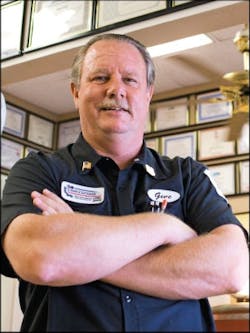In 2009, businesses throughout the country were struggling just to keep their doors open. Even the auto repair industry, often touted to be recession proof, was worse for wear during the throes of the economic downturn. Some shops are still reeling from the hardships of 2008–2010 and the sluggish years since.
But Certified Automotive Specialists, Gene Morrill’s shop in Glendora, Calif., defied the recession with great growth. In 2009, Morrill grew revenue nearly 10 percent, to $2.1 million, a record for the shop. And business is still booming today.
“It was a phenomenal year for us,” says Morrill, 52, who has worked in the auto repair industry since 1978. “And we haven’t lost momentum.”
Certified Automotive Specialists, a 7,800-square-foot operation that cranks through 350–400 repairs a month at an average ticket of $450, is a model of success regardless of economic conditions. But Morrill says some specific strategies helped him advance while others slipped backwards, and those tactics put him in a position to thrive today. Here’s his game plan for growth in a slow economy:
Set Goals, Build a Plan
No business can grow and improve without something to strive for, Morrill says. Goals don’t have to be lofty; they just need to provide clear objectives.
Strong goals will drive how everything in the business is structured—they enable a shop operator to develop a plan for business improvement.
“You have to have a model, a plan,” Morrill says. “Most of us, we open the doors every day and say, ‘I hope I have cars,’ then panic and throw out crappy mailers that don’t work.”
Morrill’s primary goal today is 20 percent net profit, which he has achieved, though not consistently—yet. But he knows exactly what he needs from his shop to get there.
“Every day, I come in and my goal is 18 cars a day, a minimum ARO (Average Repair Order) of $450 and a 60 percent gross profit on parts and labor,” he says. “I don’t care how we get there, but at the end of the day, those 18 cars need to average out to $450 a car. It has to be legit.”
Those volume and sales goals are communicated to staff, so everyone is working toward the same targets.
Goals also influence the marketing investments that help drive customers to the shop. Morrill spends $90,000 annually on marketing, which he knows from experience is necessary to get the traffic needed to meet his profit goal.
“People say, ‘Why do you do that?’ I do it so I can make 20 percent net,” Morrill says.
Don’t Let Up on Marketing
Morrill’s annual marketing budget is bigger than those at most independent shops, but in 2009, it was so large that the IRS didn’t believe it, Morrill jokes. He invested $120,000 that year in a variety of marketing tactics, including print ads, display ads and other efforts through consultation with a marketing agency, which he still uses. Some of that budget also went toward professionals he hired to craft a monthly newsletter for existing customers, and a strong social media presence that includes a popular Facebook page with more than 6,000 likes.
Some shops are hesitant to increase spending, or look outside the business for marketing assistance, but Morrill says his marketing wouldn’t be nearly as effective if he tried to take it on himself.
“I got smart and outsourced the things I don’t know how to do,” he says. “When I did it myself, we sucked at it. Now, I always hear people say our marketing is phenomenal.”
Morrill’s trademark ads, both in print and online, feature a comical cutout of his head pasted on another body, and a catchy, funny phrase. One ad features John Travolta’s body and quips, “Is your car staying alive?”
Morrill also is not afraid to try different marketing strategies, often based on the recommendations of his agency. His general rule is to invest in a strategy for at least six months and track its performance. Some tactics, such as coupons, are easy to track. His shop tracks other efforts simply by asking customers why they chose Certified Automotive Specialists. He shoots for an eight-fold return on each marketing investment.
Cut Your Car Count
It seems backwards, especially when times are tough, but Morrill says a strategy that really helped him bump business in 2009 was making a conscious effort to reduce his car count. This is something his shop still strives for today.
The idea, Morrill says, is to write more thorough estimates that lead to higher repair orders, and to spend more time taking care of the customer and educating them about the repairs. To get the car count under control, Certified Automotive Specialists became an appointment-only shop in 2009. Appointments allow Morrill and his staff to prepare for repairs and avoid the surprises and chaos that walk-ins can create. Morrill tries to keep his shop’s repairs per month close to 350 and no higher than 400. In the past, he did as many as 440 a month.
“We find that’s horrible to deal with,” he says. “You can’t get proper estimates and you’re just turning and burning. You can’t give customers what I call ‘the experience.’”
In a city of 50,000 people and 89 auto repair shops, Morrill says he needs to be on his game. Paying close attention to the needs of every customer has helped him do that.
Don’t Squander Profits
Morrill says it’s tempting to spend cash when times are good, but it’s important to save it for times such as the past several years. If business slumps, stepping up sales and marketing efforts, for instance, is a lot easier if a shop has saved up the money to do it, he says.
When Morrill’s salary (which he says is kept reasonable to protect the business), along with all of the shop’s overhead costs, staff retirement funds, IRAs and everything else is paid each month, remaining funds go into a business savings account. Morrill even started an additional “we’re in trouble account” in case there’s an extreme long-term problem.
But, Morrill says, goal-oriented planning and commitment to hitting targets is critical for earning enough to save.
“If you don’t run a tight shop, you’ll have trouble with the day-to-day,” he says. “And you won’t be able to plan for the future.”



